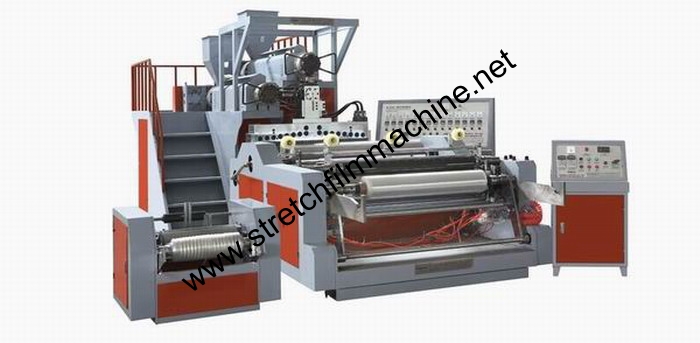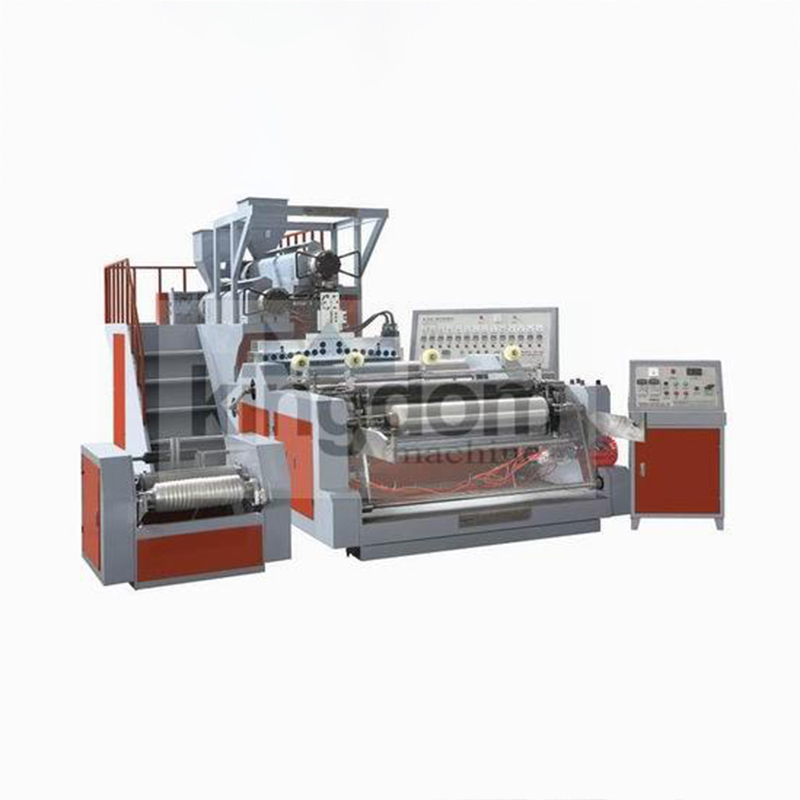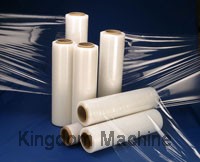Stretch Film Machine
double layer stretch film machine
.jpg)
Double layer stretch film machine uses LLDPE as main material and adopts several kinds of resins to manufacture the single/double-side self-sticky stretch wrapping film. The film has good tensile strength,anti-pricking ability and impact strength. Its good shrinking memory function and self-sticky can make goods integrity to prevent goods from loosening and collapsing during transportation and being polluted by dust. The transparency and tensile strength of this product can make the packaging beautiful, economical and practical. The film can be widely used in wrapping of palletized goods. Its a good substitute for hot shrinking packaging film during transportation. Technical Parameter:
Item/Model KD-500*2 KD-1000*2 Screw diameter(mm) 55*2 65 *2 L/D ratio of screw (L/D) 28:1 28:1 width of die head (mm) 650 1250 Width of finished products(mm) 500(250*2rollers) 1000(500*2rollers) Thickness of finished products (mm) 0.017-0.05 0.017-0.05 Structure of film layers A/B A/B Max output (kg/h) 40 100 Linear speed of machinery (m/min) 10-120 50-100 Total power (KW) 50 140 Overall dimensions (L*W*H)m 6*1.5*2.5 10*4*3 Weight (T)(About) 3 8 Optional Equipment: 1) Auto loader 2) Auto dry hopper 3) Motorize net changer 4) Hydraulic net changer 5) Air shaft 6) gule pump





CE Certificate
Kingdom Machine co.,ltd team professional produce rotogravure printing machine, blown film lines, blown film extrusion,bag making machine,flexo printing machine,stretch film machine,bubble film machine,recycle machine for over 15 years.
Kingdom Machine co,ltd
Mobile:0086-13088651008
mobile:0086-13566179950
kingdombillwang@hotmail.com
kingdombillwang@yahoo.com
http://www.gravureprintingmachine.com
http://www.blown-film-extruder.com
Ruian Economic Zone,Wenzhou,China 325200
Tel.:0086-577-65127709
Fax:0086-577-56848008
Skype:kingdombillwang
whatsapp:0086-13088651008
viber:0086-13088651008
Tango:0086-13088651008
Overwhelmed by the Complexity of ? This May Help
 Choosing a Trusted Insurance Company: What to Look For
Choosing a Trusted Insurance Company: What to Look For
In today’s complex world, having a reliable insurance company is more important than ever. Whether it’s health, auto, home, or life insurance, the right provider will not only offer you the coverage you need but also provide peace of mind knowing you’re protected against unforeseen events. However, with so many options available, selecting a trusted insurance company can be a daunting task. This article will guide you through essential factors to consider when making your choice.
One critical aspect of any insurance company is its reputation. Before making a decision, take the time to research online reviews and customer testimonials. Websites such as the Better Business Bureau (BBB) can provide insights into a company’s track record regarding customer satisfaction, claims processing speed, and any complaints filed against them. Additionally, consider seeking recommendations from friends and family. Personal experiences often reveal valuable information about an insurer’s reliability and service quality.
Another factor to weigh heavily is the financial stability of the insurance company. You want to make sure that your insurer has the financial resources to pay out claims when necessary. Organizations like AM Best and Standard & Poor’s provide ratings that evaluate an insurer’s financial strength. A company with a high rating usually indicates that it has a strong balance sheet and is capable of fulfilling its obligations to policyholders, thus providing you with an extra layer of assurance.
Additionally, consider the variety and customization options of the policies offered. A trusted insurance company should provide a range of products that can be tailored to individual needs. Look for an insurer that offers comprehensive coverage options, as well as add-ons that allow for customization to suit your unique circumstances. This flexibility ensures you’re not paying for coverage you don’t need while also making certain that crucial elements are included.
Finally, customer service plays a vital role in the overall experience with your insurance provider. Accessible customer support can make a difference, especially during stressful times like filing a claim. Look for companies that offer various channels for support, including live chat, phone support, and even mobile applications. Being able to easily reach representatives who can answer your questions and address concerns can transform your relationship with your insurer from one of frustration to one of trust.
In conclusion, choosing a trusted insurance company requires a careful evaluation of several critical factors. By scrutinizing the reputation, financial stability, policy offerings, and customer service capabilities of an insurer, you can make an informed decision that provides both coverage and confidence. Take the time to research and compare different companies, and you will be well on your way to finding an insurance partner that will serve you well in times of need.
Tips for The Average Joe

When it comes to ensuring comfort in your home, a reliable HVAC (heating, ventilation, and air conditioning) system is essential. The efficiency and effectiveness of your HVAC system largely depend on the quality of the installation and the ongoing maintenance you receive. This is why choosing the right HVAC company is crucial. In this article, we will discuss key factors to consider when selecting an HVAC contractor, helping you make an informed decision.
One of the first things to research is the credentials of the HVAC companies you are considering. Make sure that the company is licensed and insured, as this protects you and your property. A qualified HVAC contractor will have the necessary training and certifications, ensuring that they adhere to industry standards. Additionally, a reputable company will provide transparency regarding their qualifications and certifications, so don’t hesitate to ask for this information during your initial consultations.
Customer reviews and testimonials can provide insights into the reliability and quality of service offered by an HVAC company. In the digital age, it is easier than ever to research a company’s reputation online. Look for reviews on platforms like Google, Yelp, or Angie’s List. Positive feedback from previous customers is a great indicator of a company’s competency, while repeated negative reviews should serve as a warning sign. Personal recommendations from friends or family can also be invaluable when seeking credible HVAC services.
Another important aspect to consider is the range of services that the HVAC company offers. Ideally, you want to choose a company that can not only install new systems but also provide maintenance and repair services. This ensures a seamless experience and allows you to build a long-term relationship with the contractor. Furthermore, check if the company offers emergency services, which can be a lifesaver if your HVAC system fails on a sweltering summer day or a frigid winter night.
Pricing is another factor that will play a significant role in your decision-making process. While it may be tempting to go with the lowest bid, it’s important to consider the value offered by the HVAC company. Obtain quotes from multiple contractors and compare not only the costs but also the services included. A slightly higher price may be worth it for better service, longer warranties, or more energy-efficient equipment. Ultimately, balancing cost with quality is key to choosing the right HVAC company for your home.
In conclusion, selecting the right HVAC company can significantly impact your home comfort and energy efficiency. By considering credentials, customer feedback, service range, and pricing, you can make a well-informed decision that will benefit you in the long run. Take the time to do your research and choose a reliable contractor who can meet your heating and cooling needs effectively and efficiently.
: 10 Mistakes that Most People Make
Lymphatic Massage: A Comprehensive Overview to Advantages and Techniques
Lymphatic massage, usually referred to as lymphatic drainage treatment, is a mild and rhythmic massage method made to boost the lymphatic system. This essential component of the immune system plays an essential duty in removing toxic substances, excess liquids, and waste from the body. By boosting the flow of lymphatic fluid, lymphatic massage therapy assists improve circulation and promotes total health. In this write-up, we will certainly check out the advantages of lymphatic massage, its methods, and exactly how it can be integrated into your self-care routine.
Among the key benefits of lymphatic massage therapy is its capacity to reduce swelling and swelling. Many people, specifically those recovering from surgical treatment or taking care of problems like lymphedema, can experience considerable fluid retention. A competent lymphatic massage therapist makes use of gentle strokes and particular techniques to target lymph nodes and advertise water drainage. This can bring about reduced discomfort and improved flexibility, making it an excellent choice for post-operative treatment and recuperation.
In addition to physical advantages, lymphatic massage can additionally supply psychological and mental leisure. The gentle nature of the method enables customers to experience a soothing effect on their nerve system. This can be specifically useful for individuals dealing with stress or anxiety, as the soothing touch can help lower cortisol levels and advertise a feeling of well-being. By incorporating lymphatic massage right into a routine wellness routine, customers can take pleasure in boosted mental clearness and enhanced emotional health and wellness.
For those thinking about lymphatic massage therapy, it is very important to choose a skilled professional who recognizes the ins and outs of the lymphatic system. Throughout a session, expect a customized method that takes into account your certain health issues and objectives. Therapy usually lasts in between 60 to 90 mins, with the therapist using light, calculated strokes along the lymph nodes and pathways to encourage liquid activity. Customers are commonly urged to consume lots of water later to help eliminate the contaminants launched during the massage.
Finally, lymphatic massage is an important therapeutic strategy that supplies a series of physical and psychological advantages. By advertising lymphatic water drainage, it can minimize swelling, assistance recovery, and boost total health. If you’re seeking to enhance your health and wellness, consider integrating lymphatic massage therapy right into your wellness routine. With the ideal specialist, you can experience the rejuvenating results of this mild yet powerful strategy, paving the way for a healthier and extra balanced life.
5 Key Takeaways on the Road to Dominating
Comprehensive Plumbing Solutions: What You Need to Know
Pipes concerns can emerge suddenly, causing significant interruption and anxiousness for property owners and businesses alike. When confronted with such difficulties, it’s crucial to have accessibility to dependable pipes solutions that can address your requirements successfully. From routine maintenance to emergency repairs, recognizing the numerous facets of plumbing solutions can aid you make notified choices and guarantee the longevity of your plumbing systems.
One of the main services offered by plumbing experts is regular maintenance. Regular inspections and upkeep can stop small issues from intensifying right into significant troubles. This includes checking for leaks, rust, and clogs in pipelines, along with maintaining components and appliances. By organizing routine maintenance, you can conserve money in the long run while maintaining your pipes system running smoothly.
In addition to regular upkeep, plumbing solutions also concentrate on fixings. Whether it’s a dripping faucet, a clogged up drain, or a broken hot water heater, experienced plumbings have the devices and knowledge to deal with a wide variety of troubles. They can quickly detect the problem and suggest the most efficient solution, making sure that your plumbing system is back in functioning order asap. Emergency pipes services are likewise available 24/7, offering peace of mind knowing that help is simply a phone call away in important situations.
Upgrading or installing new pipes components and devices is one more essential solution offered by plumbing specialists. Whether you’re restoring your kitchen area or washroom, picking the ideal components can improve the performance and visual appeals of your area. Plumbers can assist in mounting sinks, toilets, showers, and hot water heater, ensuring that all installments adhere to regional codes and guidelines.
To conclude, plumbing services incorporate a vast selection of offerings, including regular upkeep, repair services, and installments. Recognizing these solutions can help you address your plumbing needs better and take aggressive actions to avoid difficulties down the line. Remember, when it involves plumbing, it’s always best to consult with experienced experts who can supply trusted remedies tailored to your specific needs.
Smart Tips For Finding

Air conditioning (AC) units play a crucial role in maintaining comfort in our homes and workplaces, especially during hot months. Understanding the basics of air conditioning repair can help you manage issues better and even save on costs. Here’s what you need to know.
Common AC Problems
Refrigerant Leaks: Low refrigerant levels can prevent your AC from cooling effectively. This issue often stems from leaks in the system, which require professional repair to avoid further damage.
Electrical Failures: Problems with electrical components, such as thermostats or capacitors, can lead to unit failure. Regular checks can prevent these issues, as electrical failures can also be a fire hazard.
Drainage Issues: Clogs in the condensate drain line can cause water to back up, potentially leading to water damage and increased humidity. Regular maintenance to clear the drain can help avoid this problem.
Dirty Coils: Both the evaporator and condenser coils need to be clean to function properly. Dirty coils can hinder the heat exchange process, causing your AC to work harder and inefficiently.
Fan Problems: The fan is responsible for circulating cool air. Issues here can stem from motor problems, blade damage, or dirt accumulation, resulting in poor airflow and increased energy consumption.
Maintenance Tips
Routine maintenance is key to keeping your air conditioning system operating efficiently. Here are essential tips:
Change or Clean Filters: Air filters should be checked monthly and replaced or cleaned as necessary. Clogged filters restrict airflow and reduce efficiency.
Schedule Regular Professional Inspections: At least once a year, have a professional inspect and tune-up your system. They can identify potential issues and ensure your AC is running optimally.
Clear Debris: Ensure that the area around the outdoor unit is clear of obstruction, including leaves, weeds, and debris. This helps maintain proper airflow and efficiency.
Check the Thermostat: Ensure your thermostat is functioning correctly. Programmable thermostats can help manage energy usage by adjusting the temperature based on your schedule.
Choosing a Repair Professional
When it’s time to call a professional for repair, consider the following:
Licensing and Insurance: Always check if the technician is licensed and insured. This protects you from liability in case of accidents during the repair.
Experience and Reputation: Look for established companies with good reviews. Word-of-mouth recommendations can also guide your choice.
Warranties: Inquire about warranties on parts and labor. A reliable technician should stand by their work.
Price Estimates: Obtain written estimates from multiple service providers before making a decision. Be cautious of unusually low bids, which might indicate subpar service.
DIY vs. Professional Repair
While some minor maintenance tasks can be performed by homeowners, such as changing filters or cleaning the unit, most repairs should be handled by licensed professionals. Attempting complex repairs without the necessary knowledge can lead to further damage and increased repair costs.
Conclusion
Understanding air conditioning repair can help you keep your system running efficiently and extend its lifespan. Regular maintenance, prompt attention to problems, and choosing the right repair professional are vital steps in managing your AC unit. Being proactive about your air conditioning will ensure comfort and reliability, especially during the sweltering summer months.
– Getting Started & Next Steps
 The Art of Vinyl Fencing: A Guide to Choosing the Perfect Fencing Solution for Your Sacramento Home
The Art of Vinyl Fencing: A Guide to Choosing the Perfect Fencing Solution for Your Sacramento Home
When it comes to fencing your Sacramento home, there are many options to consider. From traditional wood fences to modern metal options, each type of fence has its own unique benefits and drawbacks. However, one type of fence that is gaining popularity is vinyl fencing. Vinyl fencing is a durable, low-maintenance, and aesthetically pleasing option that can add value and curb appeal to your home. In this article, we will explore the benefits and drawbacks of vinyl fencing, as well as provide tips on how to choose the perfect vinyl fence for your Sacramento home.
Benefits of Vinyl Fencing
One of the primary benefits of vinyl fencing is its durability. Vinyl fences are made from a type of plastic called polyvinyl chloride (PVC), which is resistant to rot, mold, and mildew. This means that your vinyl fence will not warp, crack, or decay over time, unlike wood fences which can be prone to these issues. Additionally, vinyl fences are resistant to insect damage and can withstand harsh weather conditions, making them a great option for homeowners who live in areas with high winds, heavy rainfall, or extreme temperatures.
Another benefit of vinyl fencing is its low maintenance requirements. Unlike wood fences which require regular painting and staining to maintain their appearance, vinyl fences are easy to clean and maintain. Simply hose down your vinyl fence with water and a mild detergent to remove dirt and debris, and you’re good to go. This makes vinyl fencing a great option for busy homeowners who don’t have the time or desire to spend hours maintaining their fence.
Vinyl fencing is also a great option for homeowners who are looking for a fence that is easy to install. Vinyl fences come in a variety of styles and designs, including pre-assembled panels and individual pickets. This makes it easy to install your vinyl fence yourself, or hire a professional to do it for you.
Drawbacks of Vinyl Fencing
While vinyl fencing has many benefits, there are also some drawbacks to consider. One of the primary drawbacks of vinyl fencing is its cost. Vinyl fences can be more expensive than other types of fences, such as wood or metal. However, the cost of vinyl fencing can be justified by its durability and low maintenance requirements.
Another drawback of vinyl fencing is its appearance. While vinyl fences come in a variety of styles and designs, some homeowners may find that they lack the charm and character of traditional wood fences. Additionally, vinyl fences can be prone to scratches and dents, which can affect their appearance over time.
Choosing the Perfect Vinyl Fence for Your Sacramento Home
So, how do you choose the perfect vinyl fence for your Sacramento home? Here are a few tips to consider:
1. Determine your budget: Before you start shopping for a vinyl fence, determine how much you are willing to spend. Vinyl fences can range in price from a few hundred dollars to several thousand dollars, depending on the style and size of the fence.
2. Consider your climate: If you live in an area with high winds, heavy rainfall, or extreme temperatures, you may want to consider a vinyl fence that is specifically designed to withstand these conditions.
3. Think about your style: Vinyl fences come in a variety of styles and designs, from modern and sleek to traditional and ornate. Consider what style will best complement your home and yard.
4. Check the warranty: Look for a vinyl fence that comes with a good warranty. A good warranty can provide peace of mind and protect your investment.
5. Consider the installation: Vinyl fences can be installed yourself, or you can hire a professional to do it for you. Consider your level of DIY expertise and budget before making a decision.
Types of Vinyl Fencing
There are many types of vinyl fencing available, each with its own unique benefits and drawbacks. Here are a few popular options:
1. Vinyl picket fencing: Vinyl picket fencing is a classic style that features individual pickets attached to a rail. This style is great for homeowners who want a traditional look without the maintenance requirements of a wood fence.
2. Vinyl panel fencing: Vinyl panel fencing features pre-assembled panels that can be easily installed. This style is great for homeowners who want a modern look and don’t want to spend a lot of time installing their fence.
3. Vinyl lattice fencing: Vinyl lattice fencing features a lattice pattern that adds texture and visual interest to your yard. This style is great for homeowners who want to add some personality to their yard.
4. Vinyl ornamental fencing: Vinyl ornamental fencing features decorative elements such as scrolls, arches, and finials. This style is great for homeowners who want to add some elegance and sophistication to their yard.
Conclusion
Vinyl fencing is a great option for homeowners who want a durable, low-maintenance, and aesthetically pleasing fence for their Sacramento home. While there are some drawbacks to consider, the benefits of vinyl fencing make it a great choice for many homeowners. By considering your budget, climate, style, and installation options, you can choose the perfect vinyl fence for your home. Whether you’re looking for a classic picket fence or a modern lattice fence, there’s a vinyl fence out there that’s perfect for you.
A Beginners Guide To
Unlocking Success: The Power of Decision Mapping for Business Growth
In the fast-paced world of business, decision-making can often feel overwhelming. With multiple factors to consider and numerous paths to take, clarity can quickly become elusive. Decision mapping emerges as a powerful tool, enabling you to navigate complexities and drive your business towards growth.
Understanding Decision Mapping
Decision mapping is a visual approach that breaks down the decision-making process into manageable parts. It employs diagrams to represent choices, consequences, and the interrelationships between various options. By laying out decisions visually, you can better understand the potential outcomes and the way they align with your business goals. This structured method encourages clarity and helps you identify the best course of action for your organization.
The Benefits of Decision Mapping for Business Growth
Implementing decision mapping provides several advantages that can significantly contribute to your business’s growth trajectory.
First, it enhances clarity. When confronted with various options, visualizing each scenario reduces ambiguity. You can clearly see the potential outcomes associated with each choice, making it easier to weigh risks and rewards. This clarity allows you to make informed decisions that align closely with your business objectives.
Second, decision mapping fosters collaboration. Involving team members in the decision-making process can lead to richer insights and more innovative solutions. By using mapping techniques, you can engage stakeholders and encourage open dialogue. This collaborative approach not only improves the quality of decisions but also builds a sense of ownership among team members, leading to greater commitment and execution of chosen strategies.
Third, decision mapping enables proactive problem-solving. When challenges arise, having a visual representation of decision paths allows you to quickly identify alternative routes. This adaptability is crucial in today’s dynamic business landscape, where market conditions can shift rapidly. By being prepared with multiple pathways, you can pivot effectively and maintain momentum towards growth.
Steps to Implement Decision Mapping
To leverage decision mapping for your business growth, follow these essential steps:
1. Define Your Decision Context: Clearly outline the decision at hand and the objectives you aim to achieve. Understanding the context sets the foundation for effective mapping.
2. Gather Relevant Information: Collect data, insights, and feedback from team members or stakeholders. This information is essential for creating a comprehensive mapping process.
3. Visualize Your Options: Use diagrams to represent various choices, paths, and potential outcomes. Keep the visuals simple and organized to facilitate easy understanding.
4. Evaluate Each Path: Assess the pros and cons of each option. Consider factors such as risks, resource availability, and alignment with business goals.
5. Make Your Decision: Choose the path that best aligns with your objectives. Ensure that all relevant stakeholders are on board with the decision to foster collective support.
6. Review and Adjust: After implementing the decision, monitor the outcomes and gather feedback. Use this information to refine your approach and improve future decision-making processes.
Conclusion
Embracing decision mapping empowers you to navigate the complexities of business with confidence. By enhancing clarity, fostering collaboration, and enabling proactive problem-solving, this method can significantly influence your growth journey. In a world where every decision counts, adopting decision mapping as a fundamental practice can lead to smarter choices and lasting success for your business. Start visualizing your decisions today, and watch as new pathways to growth unfold.
Smart Tips For Finding
Recognizing Pairs Treatment Therapy: A Path to Healthier Relationships
Couples therapy counseling is a vital source for companions seeking to boost their relationship, resolve problems, and cultivate a much deeper understanding of one another. Many pairs experience problems that can strain their links, and looking for professional advice can supply the assistance essential to navigate these challenges. This type of counseling concentrates on improving interaction, resolving underlying issues, and fostering psychological affection between partners. By creating a secure and neutral atmosphere, couples can work through their issues and discover the characteristics of their partnership with the assistance of a qualified specialist.
Among the main objectives of couples treatment is to improve communication abilities. Often, pairs fall into patterns of inefficient interaction, which can bring about misunderstandings and resentment. Specialists utilize numerous methods to aid companions express their sensations and needs more openly and constructively. This process encourages both individuals to pay attention proactively per various other, promoting an environment of compassion and validation. Improved communication can pave the way for resolving recurring problems and minimize the probability of future misconceptions.
Along with boosting communication, couples therapy counseling allows companions to deal with much deeper problems that may be adding to their problem. These concerns might vary from previous injuries, differing worths, or life adjustments that have produced a rift in between them. The specialist’s function is to lead the conversation, helping individuals uncover and articulate these often-sensitive topics. By attending to the source of dissonance, pairs can establish an extra extensive understanding of their connection and each other, bring about lasting change and recovery.
It’s additionally necessary to acknowledge that pairs treatment is not only for relationships on the verge of break up. Numerous pairs look for therapy proactively, intending to strengthen their bond and promote an extra favorable partnership dynamic. Such preventative actions can be unbelievably valuable, as they aid partners develop healthy and balanced coping devices and analytic techniques before concerns rise. This positive technique can add to higher fulfillment and security in a partnership, creating a secure and meeting collaboration.
To conclude, pairs treatment counseling works as a vital device for companions whatsoever stages of their connection. Whether handling ongoing issues or pursuing improvement, the understandings obtained can cause much deeper emotional connections, better communication, and a healthier general collaboration. As couples look for to navigate the ups and downs of their relationships, engaging in treatment can empower them to construct a more durable structure, ultimately resulting in a better and a lot more rewarding connection.
The Path To Finding Better
Why You Required a Relied On Household Attorney
Family members legislation issues can be amongst the most psychologically billed and complex legal issues a person can encounter. Whether you are navigating a separation, dealing with youngster wardship disagreements, or taking care of home department, having actually a relied on household legal representative by your side can be vital. This post checks out the numerous reasons that employing a trusted family members lawyer is critical for any individual encountering family members regulation challenges.
Among the key benefits of engaging a trusted family attorney is their knowledge in the details of family law. The lawful system can be overwhelming, with differing laws depending upon your location. A skilled household legal representative recognizes these local legislations and guidelines, ensuring that your instance is managed correctly. They can direct you through the legal procedures, aiding you stay clear of usual mistakes and making sure that your rights and interests are protected.
Emotional assistance is another considerable advantage of working with a household legal representative. Family legislation issues often involve high stakes and individual chaos, from heartbreaking custodianship fights to the unhappiness of divorce. A compassionate attorney can give not just lawful assistance however likewise psychological support throughout the process. This connection can assist minimize a few of the tension and unpredictability that usually come with family law issues, enabling you to make even more educated decisions for yourself and your family.
A trusted household legal representative additionally possesses settlement skills that can be essential in reaching friendly settlements. Many family regulation instances can be resolved outside of court via arbitration or settlement. A seasoned legal representative can support for your rate of interests, seek fair contracts, and help avoid the time and cost connected with an extensive court fight. Their capability to bargain effectively can develop a smoother resolution procedure and preserve a more friendly relationship, particularly crucial if kids are involved.
Lastly, picking a trusted family lawyer can cause much better results in your case. With their understanding, experience, and settlement skills, attorneys can provide understanding into your instance’s strengths and weak points, preparing you for what to expect. In complex situations, having an attorney can make a substantial distinction in the last results worrying safekeeping arrangements, property division, and various other important concerns. Their depiction can make sure that your voice is heard and your interests are prioritized throughout the lawful procedures.
To conclude, when it comes to family law issues, having actually a trusted family members lawyer is not just valuable– it might be necessary for a positive end result. From their lawful expertise and psychological support to solid settlement abilities, a reputable legal representative can browse the intricacies of family members legislation while securing your rights. Whether facing a divorce, guardianship battle, or any type of various other family members concern, purchasing the right lawful representation will help you relocate in the direction of a resolution with confidence and satisfaction.